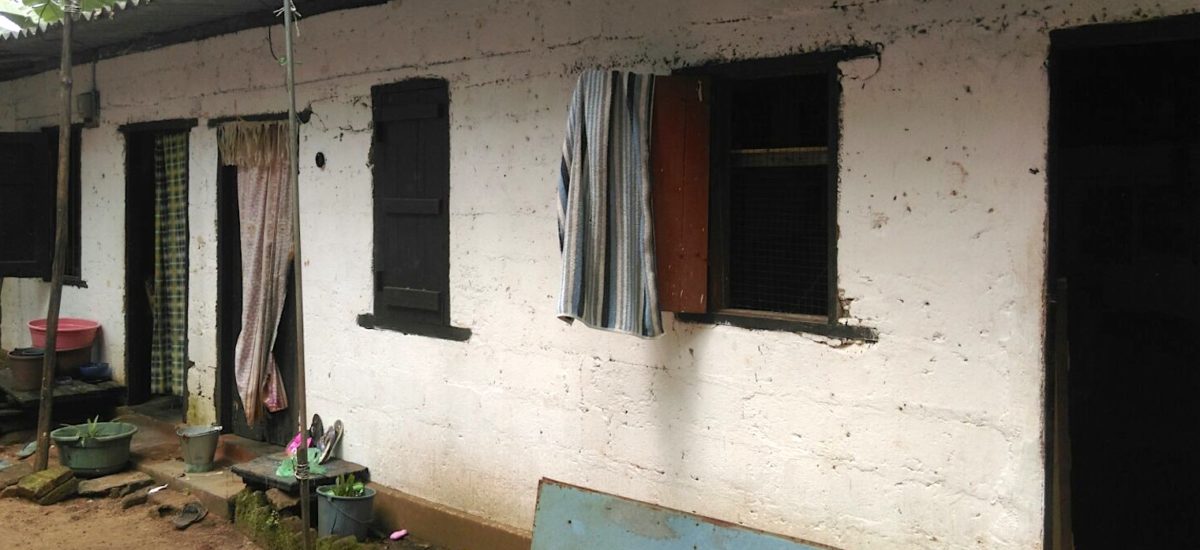Photo courtesy of Monash University
Sri Lanka’s Free Trade Zone (FTZ) workers are employed in global factories deeply embedded in global supply chains. Historically, they contribute significantly to Sri Lanka’s export income and economic development goals. Women, who make up the majority of workers in the zones and are employed in the apparel sector that constitutes the majority of factories in the zones, have been lauded as queens and the pride of Sri Lanka. Yet their experience during the COVID-19 pandemic has been anything but queenly.
Although the situation is rapidly evolving, in May there were alarming reports of increasing infection rates within factories, particularly in FTZs. Positive cases were reported from Katunayaka, Koggala and Thulhiriya FTZs. Although no accurate statistics are available, activists estimated that by May 20 this year, 50,00 workers from the 300,000 workers in the Katunayaka FTZ had contracted COVID-19. On that same day, there were reports that 16 garment factory workers from Norwood, Hatton, had COVID-19. The next day 400 new cases among workers were reported from Modaravila, Panadura and 238 reported from Koggala; over the next few days, the numbers kept increasing. By the end of the month, there were reports of garment worker deaths. Infected workers include those in the ranks of professional and management staff. In addition, activists were alarmed by news from workers that a proper process to address the care and safety of pregnant women reporting to work was not available. In June, the Sri Lankan President asked local authorities to support the continuation of factory operations in compliance with health recommendations despite infection rates. Now locals have begun to protest the operation of factories operations for fear of further spread.
Preventative health measures
When the situation came to light in May, workers and activists reported a gap in implementing health and safety guidelines by employers, which was also noted last year by the International Labour Organisation. Such gaps are being reported in global factories around the world. In Sri Lanka, there is guidance in place for testing and quarantining workers. Prominent industry representatives assert these are being followed, in addition to introducing bipartite factory level health committees after stakeholder consultations. However, activists and workers claim that there are gaps in implementation. It is unclear how many FTZ factories have implemented operational health committees. The Labour Department has strenuously denied gaps in implementation. There is very little information about the response of global buyers and retails on their expectations for Sri Lankan sourcing factories.
One reason for this reported discrepancy may be the gaps and possible misalignment in accountability mechanisms built into the employment system – these are some of the existing structural elements that make FTZ workers vulnerable. FTZ workplaces are governed by an intricate network of national labour laws enforced through Labour Department inspections and reporting, Board of Investment Guidelines adhered to via reporting, international conventions, and voluntary initiatives such as buyer codes of conduct enforced through private auditors. This system already had gaps and problematic aspects. During the pandemic, Kithmina Hewage and Angana Pathirana assert there is a lack of alignment in labour practices between the Tripartite Labour Taskforce, health inspections, and coordination between the Department of Labour, Ministry of Health, or the National COVID-19 task force.
As a result, activists demanded that the government and employers prioritize workers in vaccination initiatives. By May 30, the government added garment workers as a priority group for vaccination. The Joint Apparel Association Forum (JAAF) has now initiated a vaccination program for apparel sector workers; it is worth remembering, however, that not all workers in FTZs are in the apparel sector.
These issues have drawn attention to the implementation of COVID-19 prevention health measures in the workplace and what happens where there are infections. In particular, the process of quarantining in residential areas has come to light. This has forced a spotlight on a much-neglected area of worker wellbeing – worker housing. While over the years, harsh working conditions (lack of a living wage, sexual and gender-based harassment, diminished freedom of association, uneven occupational health and safety standards) is well documented in FTZs, less attention has been given to housing conditions.
Quarantining in boarding houses
Despite very clear instructions issued by the Ministry for Health for manufacturing and apparel sector workers to be sent to the hospital if they have symptoms, activists are reporting that workers with symptoms are sent back to their residence by factory management, along with the immediately surrounding 2 to 3 workers on the line. They are asked to quarantine there as quarantine facilities are full. What happens to workers then?
The living conditions of the factory workers were ascertained from worker activists and representatives working in the Katunayake FTZ including representatives of the Stand-Up Movement, Da Bindu Collective, Women’s Centre, and Revolutionary Existence for Human Development (RED). These organizations have been working closely with workers through the pandemic and have responded to workers in distress in their residential areas.
FTZ workers live in residences commonly known as boarding houses. The majority of workers in urban zones continue to be migrant workers from other parts of the country and rely on boarding houses for residence. While some workers live in factory operated hostels, most live in privately run operations in the areas surrounding the major urban zones (e.g. Katunayake, Biyagama). Some of these are built on the same land as the landlord’s own residence. Boarding houses accommodate single workers, families, couples, single mothers and some elders who care for children while the mothers are at work. Conditions are cramped, with shared rooms (2 to 5 people), shared toilets (3 shared among 20 to 30 people) and bathing areas, poor ventilation, limited space and questionable security.
Thus workers who are symptomatic, asymptomatic and confirmed cases who are quarantining have to share bathing areas and toilets with others. There are generally no spaces put aside since space is scarce. Couples share rooms with partners or families with each other until those who have COVID-19 are given a space in a health facility. The process to find a place in a quarantine center can take days as narrated by the activists. Those sharing rooms work in different factories so the risk of spread is increased. Workers with symptoms may be ostracized as no one else wants to be near them and some have reported difficulty finding food. Often, the boarding houses themselves are not quarantined and all people who live there are free to attend work.
“One of our members became COVID positive but her roommate was asked to report to work. The roommate underwent a PCR test only two days later and now she is quarantining till the results come. There was a vacant room in the hostel, so she moved into it for now. If not, she would have to share a room with the COVID positive friend.” Ashila Niroshanie Dandeniya, Stand Up Movement.
Some workers who are not ill but are residing in a hostel with workers who have got COVID-19 are told by their factories not to come to work.
“Workers from other factories such as United Tobacco Processing (UTP) (Pvt) Ltd. and Hirdaramani Garments Katunayake (Pvt) Ltd, who are also residing at this hostel, have been told not to come into work. But as there’s no quarantine notice outside their gate, workers fear that their leave will be cut. All nine workers share one toilet, with the worker who’s positive using it first at 5 am, followed by the rest, but, as they don’t have access to proper sanitization products, there is a high risk of the virus spreading.” FTZ and Manpower workers impacted by COVID-19 Situation update.
PHIs are meant to come and check on workers diagnosed with COVID-19 but activists say that notices are not always put outside quarantine places. There are also reports of patients being discharged early and of the lack of facilities.
“I know of one person who had symptoms who got COVID-19 and was in the boarding room for three days and taken by the authorities and brought back to the boarding after four more days. This is less than the mandatorily required quarantine period. He had to share the room with his wife who is pregnant. Other workers in the same boarding now are coughing and showing flu-like symptoms.” Chandra Devanarayana, Revolutionary Existence for Human Development.
Even if they are taken to a quarantine facility, workers with caring responsibilities and dependents are left in dire circumstances.
“Some workers are looking after old parents; one has a three-month-old baby. They will only take the worker [to the quarantine facility], which is an issue. There is no humaneness in the process. The area is also under lockdown, so who will take care of their dependents?” Ashila Niroshanie Dandeniya, Stand Up Movement.
Activists report that workers do not get paid leave to quarantine. Permanent workers who have annual leave can use their annual leave to quarantine when they become positive with the virus and if they are in immediate contact. Workers in Katunayake report that most factories continue to provide the basic wage for workers with ongoing employment contracts when there is no annual leave. The lack of leave and income means workers are not sharing that they are symptomatic until they have advanced symptoms; economic insecurity drives them to continue working.
This situation is particularly dire for agency-hired workers known as manpower workers who are hired on a daily contract basis. The activists report that such workers do not have food or access to hand wash or sanitizer. They are now struggling to pay boarding fees. Their work opportunities are shrinking, with some factories offering month-long verbal commitments at most. One of the demands of the activists is to include manpower workers as beneficiaries of the government’s Rs. 5,000 relief package.
Finding food has become an ordeal for some of the workers, who were not receiving living wages to begin with, especially the ones who have had pay cuts and are either COVID-19 positive or in quarantine. The activists regularly take to their social media accounts to highlight cases of entire boarding houses in lockdown with limited food supplies. It is reported that some factories such as ATG and B2 Engineering gave food packets for all three meals to quarantining workers. Others such as MAS and Brandix gave rations. Some workers are not receiving government payments. Local women’s and community groups are stepping in to ensure workers have enough food. Even then, the groups are struggling with finding funds to purchase supplies.
“In the first and second wave, we were also helping by distributing rations, but we have not received any funding yet and cannot start it. Workers are asking us whether we are distributing again but as of now, we haven’t received funding for that.” Padmini Weerasooriya, Women’s Centre, Ekala.
While attention is starting to be paid to the gaps in implementation of health guidelines within factories and vaccinations are being promised for some sections of the FTZs workforce, little attention is being given to housing conditions and resulting insecurity. This neglect can enable COVID-19 to flourish; while a long disregarded aspect of daily life for workers in FTZs, turning attention to worker housing may be the difference between a contained disaster and outright necrocapitalism.


